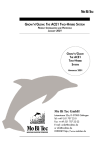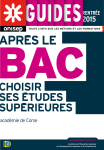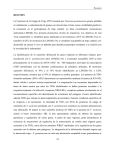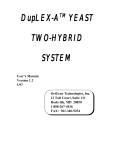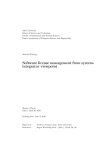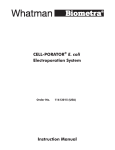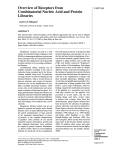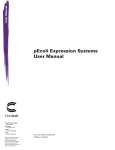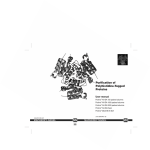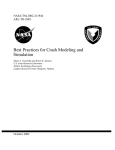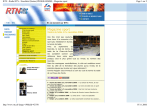Download Grow`n`Glow: The GFP One
Transcript
Grow'n'Glow: The GFP One-Hybrid System Product Information and Instructions December 2002 pGNG2 12/2002 1 Content 1. 1.1. 1.2. 1.3. 2. 3. 4. 4.1. 4.1.1. 4.1.2. 4.1.3. 4.2. 4.2.1. 4.2.2. 4.2.3. 4.3. 5. 5.1. 5.1.1. 5.1.2. 6. 7. 7.1. 7.1.1. 7.1.2. 7.1.3. page Introduction ............................................................ General .................................................................. Background ............................................................ Green Fluorescent Protein (GFP) ............................... Advantages of the Grow'n'Glow System ................. Schematic Overview of the Grow'n'Glow System ..... Kit Components ...................................................... DNA Vectors ........................................................... GFP Reporter Vector pGNG2 ................................... Prey Plasmid pJG4-5 ............................................... Control Plasmids ..................................................... Primer .................................................................... GNGprimer ............................................................ 5'-PREYprimer ......................................................... 3'-PREYprimer ......................................................... Yeast Strain............................................................. Materials Required, but not Supplied ....................... Recipes for Media ................................................... Grow'n'Glow Yeast Growth Media ........................... Grow'n'Glow Bacterial Growth Media ...................... Growth and Maintenance of Yeast ........................... Grow'n'Glow One-Hybrid System Protocol .............. Reporter-Bait Construct ............................................ GFP Reporter and Prey Plasmid ................................ Bait Element: Tandem Copy Synthesis ....................... Tandem Copies of Bait Upstream of GFP Reporter ...... Gene ...................................................................... 7.1.3.1. Reagents and Materials ........................................... 7.1.3.2. Annealing of Sense/Antisense Oligonucleotides ........ 7.2. Construction of the GFP Reporter-Bait Strain .............. 7.3. Screening a Grow'n'Glow cDNA Library for DNA Binding Protein Genes ..................................... 7.3.1. Reagents and Materials Required ............................. 7.3.2. Large-Scale Yeast Transformation ............................. 7.3.3. Plating the Transformations ...................................... 7.3.4. Isolating the Prey Plasmid from Putative Positive ......... Yeast Colonies......................................................... 7.3.5. Prey Plasmid Identification by PCR ............................ 4 4 5 5 6 7 8 8 8 9 9 10 10 10 10 10 11 11 12 13 14 14 14 14 15 15 15 16 16 17 17 18 19 19 20 pGNG2 12/2002 2 7.4. 7.5. 7.5.1. Confirmation of DNA Binding Activity ...................... Troubleshooting Guide ............................................. Excessive Background Growth and Fluorescence on Library Screening Medium ....................................... 7.5.2. Low Transformation Efficiency when Screening a ....... Grow'n'Grow Library .............................................. 7.5.3. False Negative Results ............................................. 8. Literature ............................................................... Appendix I: Small-Scale Yeast Transformation Procedure ....... Reagents and Materials Required ........................ Tips for a Successful Transformation ..................... Small-Scale Yeast Transformation Protocol ............ Appendix II: Competent E. coli Cells and Transformation ......... Competent Cells ................................................. Buffers ............................................................... Transformation of Recombinant Plasmids into E. coli Appendix III: Order Information ............................................. Related MoBiTec Products .................................... 21 23 23 23 24 25 27 27 27 28 29 29 30 30 31 31 The Grow'n'Glow system was developed by Dr. Robert S. Cormack and Dr. Imre E. Somssich at the Max-Planck-Institut für Züchtungsforschung, Cologne, Germany. The system is patented. NOTE: FOR RESEARCH PURPOSES ONLY! NOT FOR DIAGNOSTIC OR THERAPEUTIC USAGE. We will replace, at no cost, any product of ours that does not meet our standard product specifications. No other warranties, expressed or implied, are given with our products. MoBiTec GmbH is not liable for any damages due to the use of this product nor are we liable for the inability to use this product. PLEASE NOTE THAT THIS KIT IS FOR USE BY THE PURCHASER ONLY AND IS NOT TO BE DISTRIBUTED TO THIRD PARTIES WITHOUT THE WRITTEN CONSENT OF MOBITEC GMBH. Licence for GFP: This product is sold under licence from Columbia University. Rights to use this product are limited to research use only; NOT FOR DIAGNOSTIC OR THERAPEUTIC USE IN HUMANS OR ANIMALS. No other rights are conveyed. Inquiry into availability of a license to broader rights or the use of this product for commercial purposes should be directed to Columbia Innovation Enterprise, Columbia University, Engineering Terrace-Suite 363, New York, New York 10027, USA. pGNG2 12/2002 3 1. Introduction 1.1. General The Grow'n'Glow GFP One-Hybrid Kit isolates genes for proteins that bind a specific DNA element of interest (Strubin et al., 1995 and Luo et al., 1996). In addition to finding novel DNA binding proteins, the one-hybrid system can be used to investigate the bases and amino-acids involved in specific DNA-protein interactions. Proteins can be found that bind to any short DNA element of interest. The Grow'n'Glow system offers maximal sensitivity because detection of the DNA-protein interaction occurs in vivo, where proteins are more likely to be in their native conformation. Use of the Green Fluorescent Protein (GFP) reporter eliminates the timeconsuming β-galactosidase lift assays. The particular GFP variant expressed by the GFP reporter plasmid, GFPuv, has the same excitation and emission maxima as wild-type GFP, but is 18 times brighter than the wild-type variant (Crameri et al., 1996). It is easily detected by placing the plate (without the lid!) with the yeast colonies on a standard 300 nm UV transilluminator or, better, under a UV hand lamp in a darkroom. With this sensitive variant, positive colonies with DNA binding proteins glow a bright green, which is easily seen by eye under UV illumination. Expression of fusion proteins by the prey plasmid is controlled by the GAL1 upstream activation sequence. In yeast with an intact galactose regulatory system, the GAL1 activation sequence is induced by galactose and repressed by glucose. This regulation provides a mean to prevent expression of library/ activation domain fusions until the actual screening, which avoids any potentially toxic library proteins affecting growth of the yeast. These sort of toxic proteins would be missed during screening in a non-inducible system. For the Grow'n'Glow One-Hybrid assay, prepare a yeast reporter plasmid containing the sequence of a specific bait element upstream of the reporter gene GFP. For this purpose, at least three tandem copies of a known bait element are required. The bait elements are then inserted upstream of the reporter gene promoter of the GFP reporter vector using the available unique restriction enzymes (chapter 4.1.1.). Then, this construct (reporter-bait vector) is transformed into yeast cells and the transformants are selected by their marker gene. To screen a library for a gene encoding a DNA binding protein of interest, the user transforms the reporter-bait strain with a Grow'n'Glow library of fusions between the bait-independent activation domain and potentially bait-specific DNA binding proteins. The transformed yeast cells are then plated on selective medium plates. If a Grow'n'Glow library hybrid protein interacts with your bait element, the transcription of the GFPuv gene is activated. The interaction can be pGNG2 12/2002 4 verified under UV-light in a darkroom where colonies with DNA protein interactions will fluoresce green. Our experience is that the Grow'n'Glow GFP One-Hybrid System has a low incidence of false positives. Next, Grow'n'Glow library plasmids are isolated from the positive transformants and characterized by sequencing. Finally, DNA binding should be confirmed by independent methods. The Grow'n'Glow GFP One-Hybrid System can also be used to map the DNA binding domain of a known DNA binding protein. The difference to the procedure described above is, that instead of transforming the reporter-bait strain with a library, activation domain fusions are prepared with gene segments corresponding to specific domains of the known DNA binding protein. These constructs are transformed into the reporter-bait strain. The GFPuv reporter is used and the GFPuv activity can be quantified using a liquid assay (commercially available). 1.2. Background Information The yeast one-hybrid system (Wang and Reed, 1993), a modified version of the two-hybrid system, rapidly identifies DNA binding proteins from either cDNA libraries or known gene sequences. The one-hybrid system exploits the bimodular structure of eukaryotic transcriptional activators. A DNA binding element of interest is cloned into the promoter region controlling expression of the GFPuv reporter in the GFP reporter vector. A gene encoding a potential DNA binding protein is cloned in the prey plasmid so that it is expressed as a fusion to a B42 activator peptide. Interaction of the DNA binding protein with the DNA element brings the B42 activator peptide into a position that initiates transcription of the GFPuv reporter gene. Thus, colonies with DNA binding proteins that interact with the DNA element of interest are glowing brightly green, which is easily seen by eye under UV illumination (300 nm). 1.3. Green Fluorescent Protein (GFP) The GFP of the jellyfish A. victoria is activated in vivo by an energy transfer via the Ca2+-stimulation of the photoprotein aequorin (Crameri et al., 1996). The blue light generated by aequorin excites GFP and results in the emission of green light. GFP itself consists of 238 amino acids (Mr = 27 kDa) and is synthesized as an apoprotein in which post-translational formation of the chromophore occurs in an O2-dependent manner independent of any other gene products (Chalfie et al., 1994 and Cubitt et al., 1995). It maximally absorbs light at 395 nm and has an emission peak at 509 nm. The nonsubstrate requirement for GFP activity makes this protein an attractive reporter for gene expression studies and pGNG2 12/2002 5 this utility was initially demonstrated in both prokaryotes (Escherichia coli) and eukaryotes (Caenorhabditis elegans), (Chalfie et al., 1994). It has subsequently been used to monitor gene expression in many organisms including mouse (Chiocchetti et al., 1997), Drosophila (Yeh et al., 1995), zebrafish embryos (Meng et al., 1997), Arabidopsis (Wilson et al., 1991) and yeast (Niedenthal et al., 1996). In addition to the non-invasiveness of GFP detection (long-wave UV light) the protein is very stable, non-toxic and resistant to photobleaching. These properties make GFP a viable alternative to traditional reporter genes such as β-galactosidase (LacZ), β-glucuronidase (GUS), chloramphenicol acetyltransferase (CAT) or firefly luciferase which require substrate for their detection. Several modifications of the wild-type GFP cDNA have been engineered with optimized codon usage, improved fluorescence activity and red- or blue-shifted variants with altered excitation maxima intended for fluorescence microscopy (Cubitt et al., 1995). The A. victoria GFP variant, GFPuv, used in this one-hybrid system, is optimized for maximal fluorescence by UV-light excitation (360 - 400 nm) making it fluoresce 18 times brighter than wild-type GFP while retaining identical excitation and emission wavelength maxima. 2. Advantages of the Grow'n'Glow One-Hybrid System • isolates genes for novel DNA binding proteins • maps residues and regions responsible for DNA-binding • non-invasive, chemical-free and cost-free assay • positive colonies fluoresce bright green • therefore, one-step selection of potential positives under UV light • no time consuming β-galactosidase lift assays as essential in most conventional assays • antibodies to HA-tag (fused downstream of B42) permit simple immunoprecipitation of potential positives • finds potentially toxic protein by screening with galactose inducible expression libraries pGNG2 12/2002 6 pGNG2 12/2002 7 protein does not bind to DNA target element promoter prey B42 Yeast strain transformed with: no transcription colony is not fluorescent pGNG2 vector target elementGFP GFP reporter gene The One-Hybrid Approach: B42 prey transcription GFP reporter gene DNA binding protein, transactivation target element promoter green fluorescent colony B42-prey (cDNA library) prey vector 3. Schematic Overview of the Grow'n'Glow One-Hybrid System 4. Kit Components Vectors Primer Host Strain pGNG2* GNGprimer Yeast strain EGY48 pJG4-5* 5'-PREYprimer pGNG2-p53* 3'-PREYprimer pJG-4-5-p53* *Re-dissolve lyophilized vector DNA in TE-buffer (pH 8.0) Order information see Appendix III. 4.1. DNA Vectors 4.1.1. GFP Reporter Vector The reporter plasmid pGNG2 is suited for one-hybrid screens with the reporter gene GFP. This GFPuv gene is driven by a GAL1,10 minimal promoter. The 6.51 kb plasmid contains a URA3 selectable marker, 2 µm origin to allow propagation in yeast, and the ampicillin resistance gene (AmpR) and origin of replication (pBR ori) for propagation in Escherichia coli. pGNG2 has unique restriction sites for Not I, Nru I and Spe I suitable for cloning a DNA target element of interest for a one-hybrid screen. Cloning site for One Hybrid (Not I/Nru I/Spe I) GAL1,10 promoter pBR ori GFPuv Amp R pGNG2 6541 bp 2µm ori ADH1 terminator URA3 pGNG2 12/2002 8 4.1.2. Prey plasmid pJG4-5 The prey plasmid pJG4-5 (Crameri et al., 1996) is used to express cDNAs or other coding sequences inserted into the EcoR I and Xho I sites as translational fusions to a cassette consisting of the SV40 nuclear localization sequence, the 88-residue acidic activator B42 (acid blob) and the HA (hemagglutinin) epitope tag. Fusion protein expression is controlled by the GAL1 inducible promoter, thus, transcription levels are very low in the presence of glucose and high with galactose. For selection in yeast, the vector contains the TRP1 (tryptophan) marker and the 2 µm origin of replication; for propagation in E. coli an ampicillin resistance (AmpR) and pUC origin are present. TRP1 Amp R pUC ori Prey Plasmid 6449 bp 2µm ori GAL1 promoter ADH terminator B42 cassette cloning site for cDNA library: EcoR I - Xho I pJG4-5 polylinker: 5'-CCC GAA TTC GGC CGA CTC GAG AAG-3' EcoR I Xho I Polylinker of the vector indicating the open reading frame. The shown restriction endonucleases are only located in the polylinker. 4.1.3. Control Plasmids GFP positive control vector pGNG2-p53: The GFP positive control reporter vector pGNG2-p53 consists of pGNG2 and 3 tandem repeats of the mouse p53 consensus sequence cloned into the Not I/Spe I sites of the pGNG2 MCS upstream of the Gal1,10 promoter. insert: 3 x p53 consensus sequence (Not I/Spe I) GAL1,10 promoter pBR ori GFPuv Amp R pGNG2-p53 6608 bp pGNG2-p53 serves as positive control in combination with the prey control vector pJG45-p53 which carries the mouse p53-cDNA. 2µm ori ADH1 terminator URA3 pGNG2 12/2002 9 Prey control plasmid pJG4-5-p53: The prey control plasmid pJG4-5-p53 consists of pJG4-5 and the sequence of the mouse p53-cDNA (cloned into the EcoR I/Xho I sites of pJG4-5) which is fused to the B42 activation domain. Amp R TRP1 pUC ori pJG4-5-p53 7431 bp GAL1 2µm ori promoter B42 cassette 4.2. Primer ADH terminator insert: p53-cDNA (EcoR I - Xho I) 4.2.1. GNGprimer 5’-GCC CAA TAC GCA AAC CGC CT- 3’ This sequence is situated 38 bp upstream of the unique Not I restriction site. Used to verify bait DNA introduced within the cloning sites of pGNG2 by sequencing the construct. 4.2.2. 5'-PREYprimer 5'-CTG AGT GGA GAT GCC TCC-3' 5'-forward primer used to determine the reading frame and identity of positive clones in pJG4-5; can be used with 3'-primer to amplify clone by PCR*. 4.2.3. 3'-PREYprimer 5'-GCC GAC AAC CTT GAT TG-3' 3'-primer used to determine the identity of positive clones in pJG4-5; can also be used with 5'-primer to amplify clone by PCR. *PCR is a process covered by patents owned by Hoffmann-La Roche. Use of this process requires a licence 4.3. Yeast Strain The provided yeast strain is a high-sensitivity strain and has the following genotype: S. cerevisiae EGY48: MATα, trp1, his3, ura3, leu2::6 LexAop-LEU2. It is frozen in YPD medium containing 15 % glycerol and can be stored indefinitely at -70°C. pGNG2 12/2002 10 5. Materials Required, but not Supplied Note: The specific materials listed below are the ones we have tested in the Grow'n'Glow System. For order information see Appendix III. Similar items from other sources may be interchangeable. 1. Grow'n'Glow Yeast Growth media (see chapter 5.1.) 2. Grow'n'Glow Bacterial Growth media (see chapter 5.1.) 3. Ampicillin, Boehringer Mannheim order # 835 269 4. Grow'n'Glow Yeast Transformation kits (MoBiTec order # 2100-1 and # 2200-1) 5. Grow'n'Glow Yeast Plasmid Isolation kit (MoBiTec order # 2069-1) 5.1. Recipes for Media For optimal results, we highly recommend to use the Grow'n'Glow Yeast and Bacterial Growth Media offered by MoBiTec (see chapter 5.1.1. and 5.1.2.), which are optimized for one-hybrid systems. Rich medium YPD and the standard Wickerham yeast nitrogen base with carbon source optimized for S. cerevisiae can be added to water and autoclaved without the need to make concentrated solutions of vitamins, trace elements, salts or carbon sources. The powder dropout base formulation which is called Drop Out Base (DOB) medium or DOBA (with Agar) is a standard Wickerham yeast nitrogen base with a carbon source. A complete supplemented synthetic defined medium is easily made by mixing two powders, DOB (or DOBA) and Complete Supplement Mixture (CSM). The formulation of CSM is a dropout supplement for virtually all strains of S. cerevisiae containing different combinations of amino acids, adenine and uracil. Cells grow vigorously in DOB supplemented with CSM. These media are very easy to handle and are delivered as powder. Some of our media are available in small bags with the appropriate amount of powder for 0.5 litre medium (10 bags per package are sufficient for 10 x 0.5 litre medium). Just add water and autoclave - ready! For order informations see Appendix III. pGNG2 12/2002 11 5.1.1. Grow'n'Glow Yeast Growth Media Notes: DOB = Drop Out Base DOBA = Drop Out Base with Agar "-TRP" signifies medium lacks tryptophan "-URA" signifies medium lacks uracil a) YPD and YPD agar (rich medium; 20 g peptone, 10 g yeast extract, 20 g glucose, pH 6.5, 17 g agar per litre): YPD Broth: Pour the entire content of the YPD broth bag (MoBiTec order # 4001-1) into a 0.5 l flask, add 500 ml H2O. Autoclave. Ready for use. YPD Agar: Pour the entire content of the YPD agar bag (MoBiTec order # 4001-2) into a 0.5 l flask, add 500 ml H2O. Autoclave. Pour into plates. Ready for use. b) DOB media and DOBA agar with glucose or galactose/raffinose (selective medium; 1.7 g yeast nitrogen base, 5 g ammonium sulfate, 20 g glucose or 20 g galactose and 10 g raffinose, 17 g agar per litre): DOB -URA (glucose): Pour the entire content of a DOB glucose bag (MoBiTec order # 4025-1) and 0.385 g CSM -URA (MoBiTec order # 4511-2) into a 0.5 l flask, add 500 ml H2O. Autoclave. Ready for use. DOBA -URA (glucose): Pour the entire content of a DOBA glucose bag (MoBiTec order # 4026-1) and 0.385 g CSM -URA (MoBiTec order # 4511-2) into a 0.5 l flask, add 500 ml H2O. Autoclave. Pour into plates. Ready for use. DOB -TRP -URA (glucose): Pour the entire content of a DOB glucose bag (MoBiTec order #4025-1) and 0.36 g CSM -TRP -URA (MoBiTec order # 4520-5) into a 0.5 l flask, add 500 ml H2O. Autoclave. Ready for use. pGNG2 12/2002 12 DOBA -TRP -URA (glucose): Pour the entire content of a DOBA glucose bag (MoBiTec order # 4026-1) and 0.36 g CSM -TRP -URA (MoBiTec order # 4520-5) into a 0.5 l flask, add 500 ml H2O. Autoclave. Pour into plates. Ready for use. DOB -TRP -URA (galactose/raffinose): Pour 18.4 g DOB Gal/Raf (MoBiTec order # 4025-2) and 0.36 g CSM -TRP -URA (MoBiTec order # 4520-5) into a 0.5 l flask, add 500 ml H2O. Autoclave. Ready for use. DOBA -TRP -URA (galactose/raffinose): Pour 18.4 g DOBA Gal/Raf (MoBiTec order # 4026-2) and 0.36 g CSM -TRP -URA (MoBiTec order # 4520-5) into a 0.5 l flask, add 500 ml H2O. Autoclave. Pour into plates. Ready for use. 5.1.2. Grow'n'Glow Bacterial Growth Media a) LB Medium: Pour the entire content of a LB medium bag (MoBiTec order # 3002-1) into a 0.5 l flask add 500 ml H2O. Autoclave. Cool to at least 37°C. Ready for use. b) LB Agar Medium: Pour the entire content of a LB agar medium bag (MoBiTec order # 3002-2) into a 0.5 l flask add 500 ml H2O. Autoclave. Cool to at least 55°C. Pour into plates. c) LB Amp Medium (ampicillin selection): Cool the LB Medium above to at least 55°C and add 2 ml of 50 mg/ml ampicillin (in distilled water, filter-sterilized) per litre of medium. Mix. d) LB Amp Agar Medium (ampicillin selection): Cool the LB Agar Medium above to 55°C and add 2 ml of 50 mg/ml ampicillin (in distilled water, filter-sterilized) per litre of medium. Mix. Pour into plates. pGNG2 12/2002 13 6. Growth and Maintenance of Yeast The yeast strain (Saccharomyces cerevisiae; see chapter 4.3.) in our kit is provided in YPD medium with 15 % glycerol and can be maintained indefinitely at -70°C. To recover the yeast strain from the frozen glycerol stock, scrape a small amount of frozen cells from the frozen stock with a sterile loop or wooden stick and streak them onto a YPD plate. Incubate plate at 30°C for 1 - 3 days until colonies appear. Seal this working stock plate with Parafilm and store at 4°C. Propagate additional cultures only from isolated single colonies on this plate. You should restreak this plate every 2 - 3 weeks. Note: The cells may have settled to the bottom of the tube before the stock was frozen. If this happens, thaw the frozen culture on ice and vortex it before restreaking. The stock can be refrozen. Healthy yeast colonies grow to > 2 mm in diameter. Avoid small white colonies (< 1 mm) which are cells with spontaneous mutations (1 - 2 %) that eliminate mitochondrial function (Holm, 1993) when you inoculate a culture. General remarks: Yeast can be grown on plates or in liquid culture, like E. coli. However, antibiotics, which work on E. coli, do not work on yeast, making good sterile technique mandatory when working with yeast. The optimum growth temperature for yeast is 28 - 32°C. The growth rate is relatively rapid, with a doubling time of 90 - 120 minutes. Budding yeast is very amenable to genetic and molecular biological methods due to its ability to be transformed by foreign DNA and its highly efficient system of homologous recombination. General knowledge: Users should be familiar with basic molecular biology and microbiological techniques (Ausubel et al., 1997; Sambrook et al., 1989). 7. Grow'n'Glow One-Hybrid System Protocol 7.1. Reporter-Bait Constructs 7.1.1. GFP Reporter Vector and Prey Plasmid In order to screen a cDNA for DNA binding proteins using the Grow'n'Glow One-Hybrid System a true or putative bait element has to be identified. The bait element must be precisely defined using, for example, deletion and/or point mutation analysis. Prepare a construct composed of three or more tandem copies of your bait regulatory element bordered by restriction sites and insert it upstream of the reporter gene in the multiple cloning site of the GFP reporter pGNG2 12/2002 14 plasmid. This may alter the level of background GFPuv expression. Therefore, constructs should always be tested for GFPuv expression under UV-light. The prey plasmid carries the GAL1 promoter which is induced by galactose and inhibited by glucose. This feature ensures that even toxic proteins can be expressed. 7.1.2. Bait Element: Tandem Copy Synthesis At least three tandem copies of the bait element should be inserted upstream of the reporter gene (Ghosh et al., 1993). Various methods (e.g. Liaw, 1994) are available to generate tandem copies, however, we have found the most convenient and reliable method for generating them to be oligonucleotide synthesis, since well-defined regulatory elements are usually smaller than 20 bp. 1. Two antiparallel oligonucleotides are designed, one representing the sense strand and the other its antisense complement. The sense strand should consist of at least three tandem copies of the bait element with a different restriction site on each end. When the two strands are annealed, the resulting doublestranded DNA will have a different overhang at each end for directional cloning into the reporter plasmid's multiple cloning site. 2. Synthesize both strands without 5'-phosphates. 7.1.3. Tandem Copies of Bait inserted Upstream of GFP Reporter Gene 7.1.3.1. Reagents and Materials Required • Bait element: Sense- and antisense-strand oligonucleotide • Competent E. coli cells (Sambrook et al., 1989) • T4 DNA ligase • 10x T4 ligation buffer (Sambrook et al., 1989; or the buffer provided with the commercial enzyme) • Not I, Nru I, Spe I, Xba I and other restriction enzymes • LB/amp plates • 50 mM NaCl (autoclaved) • Materials for purifying plasmid from E. coli transformants (Grow'n'Glow Yeast plasmid isolation kit can be used as well; MoBiTec order # 2069-1) pGNG2 12/2002 15 7.1.3.2. Annealing of Sense/Antisense Oligonucleotides Construction of the bait element for cloning into the GFP reporter vector: 1. For each construct planned, mix 0.1 µg of sense-strand and 0.1 µg of antisense-strand oligonucleotide of the bait element in 10 µl of 50 mM NaCl. 2. Anneal the bait element oligonucleotides by heating at 70°C for 5 minutes and then slowly cooling to room temperature (~ 30 minutes). 3. Completely digest 0.1 µg of the GFP reporter plasmid in a 20 µl double digest using an appropriate pair of restriction enzymes such as those recommended below. Incubate at 37°C for 2 hours, or as directed by the enzyme manufacturer. • GFP reporter: Not I, Nru I and Spe I, (Xba I). Electrophorese 2 µl of the digest on an 1 % agarose gel to confirm that the plasmid has been efficiently linearized. 4. Mix 5 µl of the GFP reporter digested plasmid, with 1 µl of annealed oligo. Add 4 µl of H2O. 5. Add 1.2 µl of 10x T4 ligation buffer and 0.8 µl (at least 0.8 units) of T4 DNA ligase, and incubate at room temperature for 4 hours. Note: Since the molar ratio of oligonucleotide to vector is 100 :1 or greater, no gel purification to remove the stuffer fragment is required. 6. Transform competent E. coli cells with each construct using a standard method (Sambrook et al., 1989). 7. Plate transformants on LB/amp plates, and incubate at 37°C overnight. 8. Prepare plasmid using any standard method that yields highly pure DNA (Sambrook et al., 1989) or use the MoBiTec plasmid isolation kit (order # 2069-1) for yeast which can also be used for plasmid DNA in E. coli. Check for inserts by sequencing across the junctions with the GFP reporter primer. 7.2. Construction of the GFP Reporter-Bait Strain We recommend a two-step transformation procedure instead of co-introducing the GFP reporter-bait and prey plasmid-library vectors. A small-scale transformation procedure is performed to transform the GFP reporter-bait construct into the EGY48 strain. Use the Grow'n'Glow High Efficiency Yeast Transformation kit (MoBiTec order # 2200-1) or the Grow'n'Glow Fast and Easy Yeast Transformation kit (MoBiTec order # 2100-1), which are optimized for two- and one-hybrid systems. The pGNG2 12/2002 16 Grow'n'Glow Yeast Transformation kits contain all the solutions required for transformation. Use the protocol supplied with the Grow'n'Glow Yeast Transformation kits using 200 ng of plasmid DNA for transformation or the procedure described in Appendix I. 7.3. Screening a Grow'n'Glow cDNA Library for DNA Binding Protein Genes 7.3.1. Reagents and Materials Required • DOB -URA and DOB -TRP -URA (Glu) medium (chapter 5.1.1.) • DOB -TRP -URA (Gal/Raf) agar plates medium (chapter 5.1.1.) • 15 sterile 245 x 245 x 25 mm Nunc Bio-Assay Dishes (Nunc, # 240835A) • Appropriate sterile tubes and flasks Notes: a) Prepare the selection media, and pour the required number of agar plates in advance. You will need 15 Petri dishes 22 x 22 cm DOB -TRP -URA at 37°C for the transformation. b) Allow DOB agar plates to dry (unsleeved) at room temperature for 2 - 3 days or at 30°C for 3 hours prior to plating transformation mixtures. • EGY48 yeast strain • Grow'n'Glow library plasmid DNA in solution. Your prey library should have at least 106 clones. For information on constructing your own libraries, see Vojtek, 1993; Durfee et al., 1993; and Dalton and Treisman, 1992. • Herring testes carrier DNA (Sigma) • Sterile 1x PEG/LiAc solution (prepare immediately prior to use from 10x stocks) • 100 % DMSO (dimethylsulfoxide; Sigma # D-8779) • 1x TE-buffer; prepare from 10x TE-buffer (100 mM Tris pH 7.5, 10 mM EDTA) • Sterile glass rod, bent pasteur pipette, or 5 mm glass beads for spreading transformation mixtures on plates. Note: The Yeast Transformation Systems (MoBiTec order # 2200-1 or # 2100-1) contains all the solutions required for yeast transformation optimized for use in the Grow'n'Glow Two- and One-Hybrid Systems. pGNG2 12/2002 17 7.3.2. Large-Scale Yeast Transformation This step is very critical. The number of recombinants transformed with the prey clones should be as high as possible. We therefore highly recommend the use of the Grow'n'Glow High Efficiency Yeast Transformation kit (MoBiTec order # 2200-1) for obtaining the best results (contains an optimized library transformation procedure). Otherwise, you can try the up-scaled procedure below. This protocol is scaled for screening > 1x 106 independent clones. 1. Inoculate several colonies (4 - 5) of the transformed GFP reporter-bait strain into 1 ml of DOB -URA (Glu) medium. 2. Vortex vigorously for 2 minutes to disperse any clumps. 3. Transfer this cell suspension into a flask containing 50 ml of DOB -URA (Glu) medium. 4. Incubate at 30°C for 16 - 18 hours with shaking at 250 rpm to stationary phase (OD600 > 1.5). 5. Transfer enough overnight culture to produce an OD600 = 0.2 - 0.3 into 300 ml of DOB -URA (Glu) medium. 6. Incubate at 30°C for 3 h with shaking at 230 rpm. The OD600 will be 0.4 - 0.5. 7. Centrifuge the culture in 50 ml tubes at 2000x g for 5 minutes at room temperature. 8. Discard the supernatant and vortex to resuspend each cell pellet in 25 ml of TE-buffer. 9. Pool the cells into one tube. 10. Centrifuge the cells again at 2000x g for 5 minutes at room temperature. 11. Discard the supernatant and resuspend the cell pellet in 1.5 ml of freshly prepared sterile 1x TE/LiAc. Mix well by vortexing. 12. In a sterile 50 ml tube, add 20 - 40 µg of prey plasmid library and 5 mg of carrier DNA, and mix well. 13. Add 1 ml of competent cells to the step 12 DNA mixture, and mix well by vortexing. Note: If cells are not mixed well, transformation efficiency may decline. 14. Add 6 ml of sterile 1x PEG/LiAc to the transformation mixture. 15. Mix well by inverting at least ten times. 16. Incubate at 30°C for 30 minutes with shaking at 200 rpm. pGNG2 12/2002 18 17. Add 700 µl of DMSO and mix well by gentle inversion. Do not vortex. 18. Heat shock for 15 minutes in a 42°C water bath. Occasionally invert carefully to mix. 19. Chill on ice for 2 minutes. 20. Centrifuge at 2000x g for 5 minutes at room temperature, and remove supernatant. 21. Resuspend cells in ~25 ml of TE-buffer. 7.3.3. Plating the Transformation Mixture 1. Plate 1ml of the transformation mixture on each 245 x 245 mm plate (15 plates total) containing DOB -TRP -URA (Gal/Raf) agar (chapter 5.1.1.) which stimulate the expression of the fusion proteins of the prey plasmid. Spread the cells immediately after pipetting them onto the plate. 2. Incubate at 30°C for 2 - 4 days. 3. Place the plates (without the lid) under an UV-light (365 nm) in a darkroom. Localize and isolate all colonies emitting green light using a wooden stick and streak onto a new fresh 100 mm DOB -TRP -URA (Gal/Raf) plate. 4. Incubate the isolated and restreaked putative positives at 30°C for 2 - 4 days. 5. Place the plates (without the lid) under an UV-hand-lamp in a darkroom. Identify the colonies emitting green light and inoculate these in 5 ml DOB TRP -URA (Glu) medium. Incubate at 30°C for 3 hours with shaking at 230 rpm. Continue with yeast plasmid purification (see chapter 7.3.4.). 7.3.4. Isolating the Prey Plasmid from Putative Positive Yeast Colonies We recommend the Grow'n'Glow Yeast Plasmid Isolation kit (MoBiTec order # 2069-1) providing the reagents for a fast and simple protocol for isolating plasmids from yeast. This procedure will provide plasmid DNA suitable for PCR and E. coli transformations. Otherwise you can use the methods described by Ausubel et al., 1997. We recommend that the identity of the selected clones is confirmed by independent methods. First, E. coli cells are transformed with plasmids isolated from yeast as described above. 1. Isolate plasmids from four E. coli colonies using any method that produces pGNG2 12/2002 19 highly pure DNA. Use the Grow'n'Glow Yeast Plasmid Isolation kit (MoBiTec order # 2069-1) for this purpose or consult Sambrook et al., 1989. 2. Identify the E. coli colonies containing the prey plasmid, by restriction enzyme analysis, by sequencing with the 5'-PREYprimer or by colony PCR amplification using the 5'-PREYprimer and 3'-PREYprimer (see next chapter). Note: PCR using the 5'-PREYprimer and 3'-PREYprimer with the prey vector (carrying no insert) as template DNA results in a 125 bp DNA fragment. 7.3.5. Prey Plasmid Identification by PCR* 1. Inoculate 4 colonies from each plate in 2 ml LB-Amp medium. Grow overnight at 37°C. 2. 5 µl culture are transferred to a PCR tube, centrifuged 5 seconds at maximal speed. Discard supernatant. Add 30 µl PCR-mix and mix. PCR mix: 20 pmole 5'-PREYprimer 20 pmole 3'-PREYprimer 3 µl 10x dNTP (2.5 mM dNTP) 3 µl 10x Taq DNA polymerase buffer 1 µl Taq DNA polymerase (2.5 U/µl) H2O up to 30 µl. 3. Run the reaction in a thermal-cycler as follows: 1 cycle 2 minutes 95°C 20 cycles 30 seconds 95°C 30 seconds 60°C 120 seconds 72°C 1 cycle 5 minutes 72°C 4. Load the PCR reactions on an agarose gel. Clones with an amplified insert contain a prey plasmid with an insert. 5. Go back to the cultures (see step 1.). Purify the target plasmid from positive clones with an insert using an available plasmid purification method. 6. Sequence the target plasmid insert with the 5'-PREYprimer. 7. Use the DNA sequence to search against a database of choice. * PCR is a process covered by patents owned by Hoffmann-La Roche. Use of this process requires a licence. pGNG2 12/2002 20 7.4. Confirmation of DNA Binding Activity Although none of the tests suggested below is independently conclusive, the results should provide enough convincing evidence together to support whether the Grow'n'Glow library plasmid encodes a DNA binding protein. 1. You may want to perform a positive control experiment, if a non-binding mutant of your target element is available. First prepare a mutant type construct in the GFP reporter plasmid otherwise identical to your original target reporter construct. Then transform the construct into EGY48, and transform the new reporter strain with the candidate prey library plasmid. Fluorescing colonies should result from transcriptional activation using the wild type but not mutant target, indicating that you have identified a sequence specific DNA binding protein (see Li and Herskowitz, 1993, for an example). 2. Sequence the positive library clones with the 5'-PREYprimer and compare the sequence with that of other DNA binding proteins in GenBank, EMBL or other databases. a. In case your sequencing results reveal a peptide below ten amino acids fused to the B42 activation domain (or no fusion peptide at all) keep sequencing beyond the stop codon. Another (larger) open reading frame (ORF) for a peptide that interacts with the target elements in your reporter strain may be found, which functions as a transcriptional activator. In yeast genomic libraries, where intercistronic regions are very short, nontranslated gaps upstream of ORF inserts are most commonly found. Due to the cloning of a portion of the 5'-untranslated region of the mRNA along with the coding region in the cDNA, such gaps can also occur in cDNA libraries. If the library was built in a high-level expression vector (such as the prey plasmid), a western blot analysis will reveal the presence (and size) of a B42 activaton domain fusion protein. b. It has been observed that the positive library clone is transcribed in the reverse orientation from a cryptic promoter within the ADH1 terminator (Chien et al., 1991). Your sequencing results would then fail to reveal any ORF in frame with the B42 activator coding region. The expressed proteins apparently function as transcriptional activators as well as interact with the target elements. c. In some cases, two different ORFs may be expressed as a fusion with the B42 activation domain even though a nontranslated gap comes between them due, for example, to occasional translational read-through. 3. If you have a library clone that you believe encodes a transcriptional activator, check if the protein has a nuclear localization tag as many DNA transcrippGNG2 12/2002 21 tional activators have. You may achieve a crude result by observing the predicted amino acid sequence and comparing it to known nuclear localization sequences, but of course the best evidence for a nuclear localization domain is functional evidence. For example, this could be analyzed by transferring the insert to an expression vector that will generate a fusion of the protein with a cellular localization tag, such as the green fluorescent protein. 4. Gel-shift DNA binding assay with protein extracts. When preparing yeast protein extracts for use in an electrophoretic mobility shift assay (EMSA), use a procedure that will yield native proteins. The following procedure is summarized from Arndt et al., 1987: a. Prepare an overnight culture of the yeast transformant in DOB -TRP -URA (Glu) medium (to keep selection on the prey library plasmid). The OD600 should be ~1.0. b. Centrifuge 100 ml of the culture. Discard the supernatant and resuspend the pellet in 400 µl of extraction buffer: 0.1 M Tris-HCl (pH 7.5), 0.2 M NaCl, 0.01 M β-mercaptoethanol, 20 % glycerol, 5 mM EDTA and 1 mM PMSF. c. Transfer cell suspension to a pre-chilled glass tube and add an equal volume of glass beads. Place sample on ice and vortex vigorously for ~ 10 minutes (not including pause times to allow for sample cooling). d. Allow glass beads to settle, then transfer all available liquid to another prechilled glass tube. e. Add 200 µl of extraction buffer to the liquid, add an equal volume of glass beads and vortex again as described above. f. Separate the liquid from the glass beads by centrifugation. Note: One way to do this is to punch a pinhole in the microcentrifuge tube and nest this tube inside another tube before adding the sample. Upon centrifuging, the liquid will flow through to the collection tube, leaving the beads behind. g. Freeze the liquid quickly in liquid nitrogen and store it at -70°C. h. The protein yield is typically 10 - 20 mg/ml. Use 2 - 5 µl in the EMSA. 5. Perform in vitro translation and a DNA binding assay (Wu et al., 1994). A comparison of the gel-shift results between the wild-type bait DNA element and a mutant bait DNA element may prove excellently instructive. pGNG2 12/2002 22 7.5. Troubleshooting Guide 7.5.1. Excessive Background Growth and Fluorescence on Library Screening Medium Solution 1: Check to make sure that you have prepared the selection medium correctly. Solution 2: You may have used too high amounts of the Grow'n'Glow prey plasmid for transformation. Perform a new transformation with lower amounts of the prey plasmid. Solution 3: Your inserted bait element may be interacting with yeast endogenous transcriptional activators. It may be necessary to redesign the target element and construct a new GFP reporter-bait plasmid. 7.5.2. Low Transformation Efficiency When Screening a Grow'n'Glow Library The transformation efficiency should be at least 104 cfu/µg for the library transformation. If your library transformation efficiency is lower than this, try one or more of the following suggestions. Solution 1: Repeat the experiment using more of the prey library plasmid. Check the purity of the DNA and, if necessary, re-purify it by ethanol precipitation before using it again. If you are not already doing so, we strongly recommend using the pretested and optimized carrier DNA, which is available as part of the Grow'n'Glow Yeast Transformation kits (MoBiTec order # 2100-1or 2200-1). Solution 2: Repeat the transformation, this time including a "recovery" period after the heat shock. To provide a recovery period, perform the transformation as described, but add the following steps after step 20: 1. Resuspend cells in 50 ml of DOB -TRP -URA (Glu) medium. Divide cell suspension into two 50 ml tubes. 2. Incubate cells at 30°C for 1 h with shaking at 230 rpm. 3. Centrifuge at 2000x g for 5 minutes at room temperature. Remove supernatant. pGNG2 12/2002 23 7.5.3. False Negative Results A protein that normally interacts in vivo does not interact with the bait element. Solution 1: If one of the following situations is occurring, it may interfere with the ability of the B42 activator hybrid proteins to interact with the bait element: 1. The hybrid protein cannot be localized to the yeast nucleus (see van Aelst et al., 1993, for one example). In these cases, it may help to construct hybrids containing different domains of the DNA binding protein. For example, to study proteins that normally do not localize to the nucleus, it may be necessary to generate mutant forms of the protein that can be transported across the nuclear membrane. 2. The hybrid protein folds improperly. 3. The B42 activator occludes the site of interaction. 4. The hybrid proteins are not stably expressed in the host cell. Solution 2: If according to the control in chapter 7.3.4. the transformation efficiency is too low, you may not be screening a sufficient number of library co-transformants. This can be critical, especially if a rare transcript in the source tissue encodes the interacting protein of interest. See chapter 7.5.2. above for tips on improving transformation efficiency. pGNG2 12/2002 24 8. Literature Arndt, K. T., Styles, C. und Fink, G. R. (1987). Multiple global regulators control HIS4 transcription in yeast. Science 237: 874 - 880. Ausubel, F. M., Brent, R., Kingston, R. E., Moore, D. D., Seidmann, J. G., Smith, J. A. and Struhl, K. (1997). Current Protocols in Molecular Biology. (John Wiley and Sons, Inc., New York) Chalfie, M., Tu, Y., Euskirchen, G., Ward, W. W. and Prasher, D. C. (1994). Green fluorescent protein as a marker for gene expression. Science 263: 802 - 805. Chien, C. T., Bartel, P. L., Sternglanz, R. and Fields, S. (1991). The two-hybrid system: A method to identify and clone genes for proteins that interact with a protein of interest. Proc. Nat. Acad. Sci. USA 88: 9578 - 9582. Chiocchetti, A., Tolosano, E., Hirsch, E., Silengo, L. and Altruda, F. (1997). Green fluorescent protein as a reporter of gene expression in transgenic mice. Biochim. Biophys. Acta 1352: 193 - 202. Crameri, A., Whitehorn, E. A., Tate, E. and Stemmer, W. P. C. (1996). Improved green fluorescent protein by molecular evolution using DNA shuffling. Nature Biotechnol. 14: 315 - 319. Cubitt, A. B., Heim, R., Adams, S. R., Boyd, A. E., Gross , L. A. and Tsien, R. Y. (1995). Understanding, improving and using green fluorescent proteins. Trends Biochem. Sci. 20: 448 - 455. Dalton, S. and Treisman, R. (1992). Characterization of SAP-1, a protein recruited by serum response factor to the c-fos serum response element. Cell 68: 597 - 612. Durfee, T., Becherer, K., Chen, P. L., Yeh, S. H., Yang, Y., Kilburn, A. E., Lee, W. H. and Elledge, S. J. (1993). The retinoblastoma protein associates with the protein phosphatase type 1 catalytic subunit. Genes Dev. 7: 555 - 569. Ghosh, S., Selby, M. J. and Peterlin, B. M. (1993). Synergism between Tat and VP16 in trans-activation of HIV-1 LTR. J. Mol. Biol. 234: 610 - 619. Holm, C. (1993). A functional approach to identifying yeast homologs of genes from other species. In Methods: A Companion to Methods in Enzymology 5: 102 - 109. Li, J. J. and Herskowitz, I. (1993). Isolation of ORC6, a component of the yeast origin of recognition complex by a one-hybrid system. Science 262: 1870 -1873. pGNG2 12/2002 25 Liaw, G.- J. (1994). Improved protocol for directional multimerization of a DNA fragment. Biotechniques 17: 668 - 670. Luo, Y., Vijaychander, S., Stile, J. and Zhu, L. (1996). Cloning and analysis of DNA binding proteins by yeast one-hybrid and two-hybrid systems. Biotechniques 20: 564 - 568. Meng, A., Tang, H., Ong, B. A., Farrell, M. J. and Lin, S. (1997). Promoter analysis in living zebrafish embryos identifies a cis-acting motif required for neuronal expression of GATA-2. Proc. Natl. Acad. Sci. USA 94: 6267 - 6272. Niedenthal, R. K., Riles, L., Johnston, M. and Hegemann, J. H. (1990). Green fluorescent protein as a marker for gene expression and subcellular localization in budding yeast. Yeast 12: 773 - 786. Sambrook, J., Fritsch, E. F. and Maniatis, T. (1989). Molecular Cloning: A Laboratory Manual (Cold Spring Harbor Laboratories, Cold Spring Harbor, NY). Strubin, M., Newell, J. W. and Matthias, P. (1995). OBF-1, a novel B cell-specific coactivator that stimulates immunoglobin promoter activity through association with octamer-binding proteins. Cell 80: 497 - 506. van Aelst, L., Barr, M., Marcus, S., Polverino, A. and Wigler, M. (1993). Complex formation between RAS and RAF and other protein kinases. Proc. Natl. Acad. Sci. USA 90: 6213-6217 Vojtek, A., Hollenberg, S. and Cooper, J. (1993). Mammalian Ras interacts directly with the serine/threonine kinase Raf. Cell 74: 205 - 214. Wang, M. M. and Reed, R. R. (1993). Molecular cloning of the olfactory neuronal transcription factor Olf-1 by genetic selection in yeast. Nature 364: 121 - 126. Wilson, T. E., Fahrner, T. J., Johnston, M. and Milbrandt, J. (1991). Identification of the DNA binding site for NGFI-B by genetic selection in yeast. Science 252: 1296 - 1300. Wu , F., Lerchenko, I. and Filutowicz, M. (1994). Binding of DnaA protein to a replication enhancer counteracts the inhibition of plasmid R6K gamma origin replication mediated by elevated levels of R6K pi protein. J. Bacteriol. 176: 6795-6801. Yeh, E., Gustafson, K. and Boulianne, G. L. (1995). Green fluorescent protein as a vital marker and reporter of gene expression in Drosophila. Proc. Natl. Acad. Sci. USA 92: 7036 - 7040. pGNG2 12/2002 26 Appendix I: Small-Scale Yeast Transformation Reagents and Materials Required • YPD-Medium (chapter 5.1.1.a) • Appropriate sterile tubes and flasks • Appropriate DOB -URA agar plates (chapter 5.1.1.b) • Yeast strain: EGY48 • Herring testes carrier DNA (Sigma) • Sterile 1x PEG/LiAc solution (Prepare immediately prior to use from 10x stocks) • 100 % DMSO (Dimethylsulfoxide; Sigma # D-8779) • 1x TE-buffer; prepare from 10x TE-buffer (100 mM Tris pH 7.5, 10 mM EDTA) • Sterile glass rod, bent pasteur pipette, or 5 mm glass beads for spreading transformation mixtures on plates. Tips for a Successful Transformation 1. Fresh (1 - 3 days old) colonies will give best results for liquid culture inoculation. A single large (2 - 3 mm) colony is used for the inoculum. Scrape the entire colony into the medium. If colonies on the stock plate are smaller than 2 mm, scrape several colonies into the medium (see also chapter 7!). 2. If the overnight or 3 hours cultures are visibly clumped, disperse the clumps with vigorous vortexing before using them in the next step. 3. When you are collecting cells by centrifugation, a swinging bucket rotor results in better recovery of the cell pellet. 4. For the highest transformation efficiency (as is necessary for library screening), use competent cells within 1 hour of their preparation. If necessary, competent cells can be stored (after step 10) at room temperature for several hours with a minor reduction in competence. 5. To obtain an even growth of colonies after plating, continue to spread the pGNG2 12/2002 27 transformation mixtures over the agar surface until all liquid has been absorbed. Small-Scale Yeast Transformation Protocol This protocol is for small-scale transformation, obtaining 100 - 1000 transformants. 1. Inoculate several colonies of the yeast strain 2 - 3 mm in diameter, into 1 ml of YPD medium. 2. Vortex vigorously for 2 minutes to disperse any clumps. 3. Transfer 100 µl of this cell suspension into a flask containing 5 ml of YPD medium. 4. Incubate at 30°C for 16 - 18 hours with shaking at 250 rpm until stationary phase is reached (OD600 > 1.5). 5. Transfer enough overnight culture to produce an OD600 = 0.2 - 0.3 into 50 ml of YPD medium. 6. Incubate at 30°C for 3 hours with shaking at 230 rpm. The OD600 will be 0.5 ± 0.1. 7. Centrifuge the culture in 50 ml tubes at 2000x g for 5 minutes at room temperature. 8. Discard the supernatant and vortex to resuspend each cell pellet in 5 ml of TE-buffer. 9. Centrifuge the cells again at 2000x g for 5 minutes at room temperature. 10. Discard the supernatant and resuspend the cell pellet in 300 µl of freshly prepared, sterile 1x TE/LiAc. Mix well by vortexing. 11. In a sterile 50 ml tube, add 0.2 - 1 µg of GFP reporter-bait plasmid and 50 µg of carrier DNA and mix well. (Very important that the carrier DNA is denaturated several times by boiling in a water bath.) 12. Add 250 µl of competent cells to the step 11 DNA mixture, and mix well by vortexing. Note: If cells are not mixed well, transformation efficiency may decline. 13. Add 1.2 ml of sterile PEG/LiAc to the transformation mixture. 14. Vortex at high speed for 10 seconds to mix well. 15. Incubate at 30°C for 30 minutes with shaking at 200 rpm. 16. Add 100 µl of DMSO and mix well by gentle inversion. Do not vortex. pGNG2 12/2002 28 17. Heat shock for 15 minutes in a 42°C water bath. Swirl occasionally to mix. 18. Chill on ice for 2 minutes. 19. Centrifuge at 2000x g for 5 minutes at room temperature, and remove supernatant. 20. Resuspend cells in ~200 µl of TE-buffer. 21. Plate the transformation mixture onto an 85 mm DOB -URA agar plate. 22. Incubate at 30°C for 2 - 3 days. Store the plate at 4°C, when growth is achieved. Appendix II Competent E. coli Cells and Transformation Competent Cells 1. Inoculate one colony of your E. coli strain in 5 ml SOB medium. Note: Use a freshly streaked plate with your E. coli strain of choice. 2. Incubate 250 ml SOB with 2.5 ml of the overnight culture. Incubate at 37°C while shaking at 200 rpm. Measure the OD550 after 2 - 2.5 hours. Once a density of 0.4 - 0.5 (OD550) is reached place cells on ice for 15 minutes. It is very important to keep the temperature at 0°C unless otherwise stated. 3. Pellet cells by centrifugation. Spin 10 minutes at 6000 rpm (3000 g) at 4°C. 4. Discard the supernatant. 5. Resuspend in ice-cold 80 ml RF I-buffer. Place on ice for 20 minutes. 6. Spin 6000 rpm for 10 minutes at 4°C. 7. Discard the supernatant. Resuspend the pellet in ice-cold 20 ml RF IIbuffer. 8. Aliquot the cells in 220 µl aliquots on ice. Quick-freeze immediately in liquid nitrogen or dry-ice/methanol. Store at -80°C until use. pGNG2 12/2002 29 Buffers SOB: 500 ml: 2 % (w/v) Bacto-Tryptone or peptone, 0.5 % (w/v) yeast extract, 10 mM NaCl, 2.5 mM KCl, 10 mM MgCl2, 10 mM MgSO4. Autoclave. RF I buffer: 400 ml: 100 mM RbCl (rubidium chloride), 30 mM KAc, 10 mM CaCl2, 50 mM MnCl2, 15 % Glycerol. Adjust to pH 5.8 with 0.2 M acetic acid. Autoclave. RF II-buffer: 100 ml: 10 mM MOPS, 10 mM RbCl, 75 mM CaCl2, 15% glycerol, distilled H2O to approximately 75 ml. Adjust to pH 6.8 with 1 M NaOH. Add H2O up to 100 ml. Autoclave. Transformation of Recombinant Plasmids into E. coli Note on controls: In addition to the experimental transformations described below, we recommend that you perform a negative control transformation with no DNA and a positive control transformation with 0.1 ng of an intact plasmid such as pBR322 or pUC19 (0.1 ng pUC19 should result in 100 1000 colonies). 1. Thaw the competent E. coli cells on ice to obtain maximum efficiency. Caution: Once thawed, cells cannot be refrozen. 2. Place 5 µl plasmid (for Grow'n'Glow Yeast Plasmid Isolation kit users) on ice in an 1.5 ml Eppendorf tube. 3. Add 220 µl competent cells immediately when the cells are thawed. 4. Incubate on ice for 30 minutes. 5. Incubate at 42°C for exactly 2 minutes. 6. Place immediately on ice for 15 minutes. 7. Add 200 µl LB medium. Incubate by shaking at 37°C for 1 hour. 8. Place on ice for 5 minutes. 9. Plate the whole volume from step 7 onto a LB + 50 µg/ml Amp. plate. Incubate overnight at 37°C. pGNG2 12/2002 30 Appendix III Order Information, Shipping & Storage order # description GNGK03 Grow'n'Glow One-Hybrid System: pGNG2, lyophilized DNA pJG4-5, lyophilized DNA GNGprimer 5'-PREYprimer (0.1nmole/µl) 3'-PREYprimer (0.1nmole/µl) Yeast strain EGY48, glycerol stock shipped on dry ice; vectors and primers store at 4°C, yeast strain store at -20°C amount 5 µg 5 µg 500 pmole 500 pmole 500 pmole 1 ml Related MoBiTec Products: order # description amount GNGK01 Grow'n'Glow Two-Hybrid System "complete kit" kit GNGK02 Grow'n'Glow Two-Hybrid System "basic kit" kit ACE01 Grow'n'Glow ACE1 Two-Hybrid System "complete kit" kit 2100-1 Grow'n'Glow Fast and Easy Yeast Transformation kit 200 transf. 2200-1 Grow'n'Glow High Efficiency Yeast Transformation kit 250 transf. 2069-1 Grow'n'Glow Yeast Plasmid Isolation kit 25 preps 2069-2 Grow'n'Glow Yeast Plasmid Isolation kit 100 preps pGNG2 12/2002 31 Grow'n'Glow Yeast and Bacterial Growth Media: order # description amount Bags for 0.5 litre medium each: 10 bags 4001-1 YPD broth bags (with 25 g for 0.5 litre medium each) 4001-6 YPD broth bags order # description amount 4001-2 YPD agar bags (with 33.5 g for 0.5 litre medium each) 10 bags 4001-7 YPD agar bags 4025-1 DOB* glucose bags 10 x 10 bags 10 x 10 bags 10 bags (with 13.4 g for 0.5 litre medium each) 4025-6 DOB glucose bags 10 x 10 bags 4025-2 DOB 2 % galactose/1 % raffinose (powder) 0.5 lb (227 g) 4025-7 DOB 2 % galactose/1 % raffinose (powder) 2.2 lb (1 kg) 4026-2 DOBA** 2 % galactose/1 % raffinose (powder) 4026-7 DOBA 2 % galactose/1 % raffinose (powder) 4026-1 DOBA glucose bags 0.5 lb (227 g) 2.2 lb (1 kg) 10 bags (with 21.9 g for 0.5 litre medium each) 4026-6 DOBA** glucose bags 3002-1 LB medium bags (with 12.5 g for 0.5 litre medium each) 3002-6 LB medium bags 3002-2 LB agar bags (with 20 g for 0.5 litre medium each) 3002-7 LB agar bags 4510-3 CSM -HIS supplement 10 g 4511-2 CSM -URA supplement 10 g 4520-4 CSM -HIS -LEU supplement 10 g 4520-3 CSM -HIS -URA supplement 10 g 4520-5 CSM -TRP -URA supplement 10 g 4530-8 CSM -HIS -TRP -URA supplement 10 g 4540-0 CSM -HIS -LEU -TRP -URA supplement 10 g * DOB = Drop Out Base **DOBA = Drop Out Base with Agar 32 10 x 10 bags 10 bags 10 x 10 bags 10 bags 10 x 10 bags pGNG2 12/2002
































